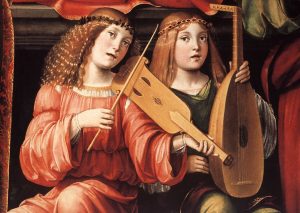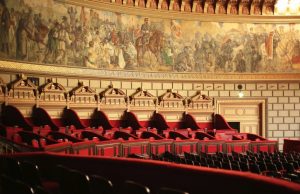Renaissance music – the period in the development of European music between approximately 1400 and 1600
MUSIC OF THE RENAISSANCE (1534-1600)
In Venice, from about 1534 to about 1600, there is an impressive polychoral with a developed style that gave Europe some of the biggest, most sonorous melodies that were up to that time, with several choirs of singers, brass and strings in various spatial locations in the Basilica of San Marco Di Venezia (of the Venetian school).
The Roman School was represented by a group of composers of predominantly church music in Rome, spanning the late Renaissance and early Baroque eras. The most famous composer of the Roman schools was Giovanni Pierluigi da Palestrina, whose name has been associated for four hundred years with smooth, clear, polyphonic perfection.

A brief but intense musical flowering was achieved by the madrigal in England, mainly from 1588 to 1627, as well as by the composers who gave birth to it. English madrigals are a cappella, predominantly in light and style, and generally began either as copies or direct translations of Italian models. Most of them had three to six votes.
The musica reservata style, or practice in a cappella performance of vocal music, mainly in Italy and southern Germany, including refinement and intense emotional expression, was sung by texts.
In addition, many composers demonstrated a division in their works between Prima Pratika (music in the polyphonic renaissance style) and Seconda Pratika (music in the new style) during the first half of the 17th century.
Baroque music
Baroque music is the period in the development of European classical music between approximately 1600 and 1750.
Baroque music appeared at the end of the Renaissance and preceded the music of the Classical era.
The writing and performing techniques of the Baroque period have become an integral and significant part of the classical musical canon.
Such concepts as music theory, diatonic tonality, imitative counterpoint have received strong development. The musical ornament has become very sophisticated, musical notation has changed a lot, and ways of playing instruments have developed. The boundaries of genres have expanded, the complexity of performing musical works has grown, and such a type of composition as an opera has appeared. A large number of musical terms and concepts from the Baroque era are still in use today.
In the Baroque era, such brilliant works as the fugues of Johann Sebastian Bach, the Alleluia choir from the oratorio Messiah by Georg Friedrich Handel, The Seasons by Antonio Vivaldi, and The Supper by Claudio Monteverdi were born.

The creation of his recitative style by the Italian composer Claudio Monteverdi (1567-1643) and the consistent development of Italian opera can be considered a conditional transition point between the Baroque and Renaissance eras. The beginning of opera performances in Rome and especially in Venice already meant the recognition and spread of the new genre throughout the country.
Renaissance composers paid attention to the elaboration of each part of a musical work, paying little or no attention to the juxtaposition of these parts. Separately, each part could sound excellent, but the harmonious result of the addition was more a matter of chance than regularity.
The appearance of the figured bass indicated a significant change in musical thinking – namely, that harmony, which is “the addition of parts into one whole”, is as important as the melodic parts of polyphony in themselves. More and more, polyphony and harmony looked like two sides of the same idea of composing euphonious music: when composing harmonic sequences, the same attention was paid to tritones when creating dissonance.
Italy becomes the center of a new style. The papacy, although captured by the struggle against the reformation, but nevertheless possessing huge financial resources replenished by the military campaigns of the Habsburgs, was looking for ways to spread the Catholic faith through the expansion of cultural influence.
One of the important centers of musical art was Venice, which at that time was under both secular and ecclesiastical patronage.
EARLY BAROQUE
Giovanni Gabrieli was a significant figure in the early baroque period, whose position was on the side of Catholicism, which opposed the growing ideological, cultural and social influence of Protestantism. His works belong to the style of the “High Renaissance” (the heyday of the Renaissance). However, some of his innovations in the field of instrumentation (the assignment of specific tasks to a certain instrument) clearly indicate that he was one of the composers who influenced the emergence of a new style.
One of the requirements imposed by the church on the composition of sacred music was that the texts in works with vocals were legible. This required a move away from polyphony towards musical techniques, where the words came to the fore. The vocals became more complex, ornate compared to the accompaniment. This is how homophony developed.
Monteverdi became the most prominent among the generation of composers who felt the implications for secular music of these changes. In 1607
